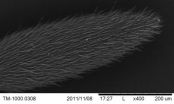(Press-News.org) SAN FRANCISCO, CA—September 11, 2012—Scientists at the Gladstone Institutes have gotten us one step closer to understanding and overcoming one of the least-understood mechanisms of HIV infection—by devising a method to precisely track the life cycle of individual cells infected with HIV, the virus that causes AIDS.
In a paper being published online today in Lab on a Chip, the laboratory of Gladstone Investigator Leor Weinberger, PhD, announced the development of a device that can pinpoint and track HIV inside CD4 T cells—the type of white blood cell that the AIDS virus targets. This development is particularly important for understanding "HIV latency," a state in which the virus goes dormant after the patient begins standard antiretroviral treatment. Current antiretroviral drugs do not kill HIV—they only keep it at bay—meaning that those with HIV must continue a lifetime of drug treatment so as not to develop AIDS. If they discontinue the drugs, the latent virus "wakes up" within just a few weeks and begins an onslaught against the body's immune system.
The breakthrough comes as the AIDS-researcher community is beginning to speak publicly about the possibility of curing HIV/AIDS. Understanding—and consequently interrupting—HIV latency is a key element in the effort to discover a cure for this devastating disease.
"HIV latency is perhaps the single greatest obstacle to eradicating HIV/AIDS in the 34 million people who live with the disease worldwide," said Dr. Weinberger, who is also an associate professor of biochemistry and biophysics at the University of California, San Francisco (UCSF), with which Gladstone is affiliated. "Existing techniques that try to uncover the cellular and viral mechanisms behind HIV latency are inefficient at studying very rare cells—and cells housing the latent HIV virus are one-in-a-million. Our technique presents a clear path towards understanding how HIV latency is regulated within a single cell, by tracking the individual cells that traditionally had been difficult to monitor."
Singe-cell, time-lapse microscopy—a state-of-the-art technique that scientists have lately used to track some viral infections and map antibiotic resistance to drugs—has not worked for tracking the HIV-infection cycle in CD4 T cells, especially in the latent state. This is because these cells are notoriously evasive. They spontaneously move around, attaching and detaching from their neighbors, making it nearly impossible to monitor individual HIV-infected cells over time.
However, Dr. Weinberger's team devised a clever system that essentially guides and suspends HIV-infected T cells into tiny finger-like channels—reducing their ability to move or detach from their neighbors.
"First, we load the T cells into a small well, allowing them to settle into the bottom—which is filled with nutrients that keep the cells well-fed and stress-free," explained the paper's lead author Brandon Razooky, a Gladstone and UCSF graduate student. "Next, we tilt the device and the cells slide into microscopic finger-like channels that are attached to the well. Finally, we return the device to its upright position, locking about 25 T cells inside each channel and essentially 'freezing' them in place."
The device has several advantages over current methods. First and foremost, individual cells stay in place so investigators can follow them over time with single-cell, time-lapse microscopy. Second, the fact that each T cell is suspended in nutrients in close physical contact with other cells results in near optimal conditions for keeping the infected cell alive for the virus' entire life cycle.
"This means that we now have the potential to analyze the entire course of an HIV infection in an individual cell—especially during the crucial latency stage—for which we know so little," said Dr. Weinberger. "In the future, we plan to expand the device's design to include a larger number of wells and channels to track HIV infection on a larger scale. We want to use the information gleaned here to finally unravel the mechanisms behind HIV latency. With that knowledge, we hope to devise a treatment to bring the latent virus out of hiding in order to flush it from a patient's system, once and for all."
INFORMATION:
This research was funded by the National Institutes of Health and the National Science Foundation.
About the Gladstone Institutes
Gladstone is an independent and nonprofit biomedical-research organization dedicated to accelerating the pace of scientific discovery and innovation to prevent, treat and cure cardiovascular, viral and neurological diseases. Gladstone is affiliated with the University of California, San Francisco.
Gladstone scientists develop technique to decipher the dormant AIDS virus concealed in cells
Novel method could help advance the fight against persistent 'HIV latency'
2012-09-11
ELSE PRESS RELEASES FROM THIS DATE:
Was Kepler's supernova unusually powerful?
2012-09-11
In 1604, a new star appeared in the night sky that was much brighter than Jupiter and dimmed over several weeks. This event was witnessed by sky watchers including the famous astronomer Johannes Kepler. Centuries later, the debris from this exploded star is known as the Kepler supernova remnant.
Astronomers have long studied the Kepler supernova remnant and tried to determine exactly what happened when the star exploded to create it. New analysis of a long observation from NASA's Chandra X-ray Observatory is providing more clues. This analysis suggests that the supernova ...
Survey shifts spotlight away from poor as key supporters of militants in Pakistan
2012-09-11
A groundbreaking survey of Pakistanis has found stronger support for militant groups among the middle class than the poor. The finding by a team including Princeton researchers challenges the conventional wisdom about links between economic status and views on militants that has helped shaped American foreign-aid policies since 2001.
The nationally representative survey of 6,000 Pakistani adults, conducted in the spring of 2009, also found that Pakistanis in general held militant groups in low regard. And, when the survey results were analyzed along with data that identified ...
High-altitude winds have large potential as a source of clean energy
2012-09-11
Airborne wind energy—an emerging approach to harnessing high-altitude winds—could scale up fairly quickly if given significant government support for research and development, according to a survey of experts by Near Zero, a nonprofit energy research organization.
Winds near Earth's surface are already used to generate substantial amounts of electricity. However, higher in the sky—much higher than today's wind turbines can reach—winds tend to be stronger and steadier, making these winds an even larger source of energy. According to recent research, the amount of energy ...
Salt seeds clouds in the Amazon rainforest
2012-09-11
It's morning, deep in the Amazon jungle. In the still air innumerable leaves glisten with moisture, and fog drifts through the trees. As the sun rises, clouds appear and float across the forest canopy ... but where do they come from? Water vapor needs solid surfaces to condense on. Airborne particles are the seeds of liquid droplets in fog, mist, and clouds.
To learn how aerosol particles form in the Amazon, Mary Gilles of the Chemical Sciences Division at the U.S. Department of Energy's Lawrence Berkeley National Laboratory (Berkeley Lab) and David Kilcoyne of the Lab's ...
UF researchers name new cusk-eels useful for understanding environment
2012-09-11
GAINESVILLE, Fla. -- A study by University of Florida and University of Kansas researchers describing eight new cusk-eel species provides data for better understanding how disasters like the 2010 Gulf of Mexico oil spill impact biodiversity and the environment.
The 60-year study appearing Tuesday in the Florida Museum of Natural History Bulletin provides a comprehensive taxonomic revision of one of the least-studied groups of cusk-eels, bony fishes distantly related to cod. Although abundant and widespread in the Americas, the fishes in the genus Lepophidium have previously ...
GEN reports on ocular therapeutics targeting the retina
2012-09-11
New Rochelle, NY, September 10, 2012-- Therapies for retinal diseases are expected to overtake those for glaucoma by 2014, reports Genetic Engineering & Biotechnology News (GEN). Because current retinal disease treatments only improve vision for six to eight weeks, there is a critical need for new remedies, according to a recent issue of GEN.
"As increasing numbers of baby-boomers continue to grow older, many will have to deal with eye diseases such as age-related macular degeneration," said John Sterling, Editor-in-Chief of GEN. "Some estimates put the current AMD and ...
Pain drug can kill resistant tuberculosis
2012-09-11
NEW YORK (September 10, 2012) -- An off-patent anti-inflammatory drug that costs around two cents for a daily dose in developing countries has been found by researchers at Weill Cornell Medical College to kill both replicating and non-replicating drug resistant tuberculosis in the laboratory -- a feat few currently approved TB drugs can do, and resistance to those is spreading.
Their findings, published online by the journal PNAS, point to a potential new therapy for the more than 500,000 people worldwide whose TB has become resistant to standard drug treatments. But ...
Rhode Island Hospital study shows wine has more cardiovascular benefits than vodka
2012-09-11
PROVIDENCE, R.I. – The next time you call someone a drunken pig, remember this study. Rhode Island Hospital researcher Frank Sellke, M.D., chief of cardiothoracic surgery at Rhode Island and The Miriam hospitals, and his colleagues studied the effects of red wine and vodka on pigs with high cholesterol and found that the pigs with a penchant for pinot noir fared better than their vodka swilling swine counterparts. The paper is published in the September issue of the journal Circulation.
"There has been previous research touting the benefits of moderate consumption of ...
Ants have an exceptionally 'hi-def' sense of smell
2012-09-11
Ants have four to five times more odor receptors than most other insects, a team of researchers have discovered.
The research team, led by Lawrence Zwiebel at Vanderbilt, recently completed the first full map of olfactory system that provides ants with their sense of taste and smell. They found the industrious insects have genes that make about 400 distinct odorant receptors, special proteins that detect different odors. By comparison, silk moths have 52, fruit flies have 61, mosquitoes range from 74 to 158 and honeybees have 174.
"The most exciting moment for me was ...
Researchers find 2 gene mutations drive adrenal cancer
2012-09-11
This press release is available in Portuguese.
ANN ARBOR, Mich. — Two different genetic mutations cooperate to induce adrenal cancer, according to a new study from researchers at the University of Michigan Comprehensive Cancer Center and University of Sao Paulo in Brazil.
The finding provides new clues to this rare and deadly cancer type, and researchers hope it will lead to better treatments by targeting both mutations.
About 600 Americans are diagnosed with adrenal cancer per year. It is typically diagnosed in late stages when there is nearly no chance of survival ...
LAST 30 PRESS RELEASES:
University of Phoenix College of Doctoral Studies releases white paper on AI-driven skilling to reduce burnout and restore worker autonomy
AIs fail at the game of visual “telephone”
The levers for a sustainable food system
Potential changes in US homelessness by ending federal support for housing first programs
Vulnerability of large language models to prompt injection when providing medical advice
Researchers develop new system for high-energy-density, long-life, multi-electron transfer bromine-based flow batteries
Ending federal support for housing first programs could increase U.S. homelessness by 5% in one year, new JAMA study finds
New research uncovers molecular ‘safety switch’ shielding cancers from immune attack
Bacteria resisting viral infection can still sink carbon to ocean floor
Younger biological age may increase depression risk in older women during COVID-19
Bharat Innovates 2026 National Basecamp Showcases India’s Most Promising Deep-Tech Ventures
Here’s what determines whether your income level rises or falls
SCIE indexation achievement: Celebrate with Space: Science & Technology
Children’s Hospital Colorado performs region’s first pediatric heart and liver dual organ transplant
Australian team discover why quantum computers have memory problems over time
What determines the fate of a T cell?
Candida auris: genetic process revealed which could be treatment target for deadly fungal disease
Groundbreaking discovery turns household plastic recycling into anti-cancer medication
Blocking a key inflammatory pathway improves liver structure and vascular function in cirrhosis, study finds
Continuous spread: Raccoon roundworm detected in nine European countries
HKUST Engineering researchers developed a novel photodetector to enhance the performance of on-chip light monitoring
Strategic river sensors could have forewarned of Texas Camp flood disaster
Drone sampling of whale breath reveals first evidence of potentially deadly virus in Arctic
Roman soldiers defending Hadrian’s Wall infected by parasites, study finds
Pinochet’s prisoners were tormented with music but still found solace in it, a new book reveals
Fertility remains high in rural Tanzania despite access to family planning
AI-assisted device can improve autism care access
Kinetic careers
Uncovering how parasitic plants avoid attacking themselves to improve crop resistance
Nanoparticle vaccine strategy could protect against Ebola and other deadly filoviruses
[Press-News.org] Gladstone scientists develop technique to decipher the dormant AIDS virus concealed in cellsNovel method could help advance the fight against persistent 'HIV latency'






